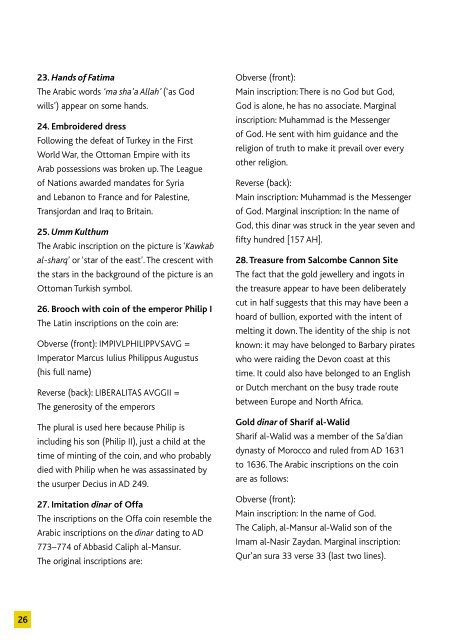Create successful ePaper yourself
Turn your PDF publications into a flip-book with our unique Google optimized e-Paper software.
26<br />
23. Hands of Fatima<br />
The Arabic words ‘ma sha’a Allah’ (‘as God<br />
wills’) appear on some hands.<br />
24. Embroidered dress<br />
Following the defeat of Turkey in the First<br />
World War, the Ottoman Empire with its<br />
Arab possessions was broken up. The League<br />
of Nations awarded mandates for Syria<br />
and Lebanon to France and for Palestine,<br />
Transjordan and Iraq to Britain.<br />
25. Umm Kulthum<br />
The Arabic inscription on the picture is ‘Kawkab<br />
al-sharq’ or ‘star of the east’. The crescent with<br />
the stars in the background of the picture is an<br />
Ottoman Turkish symbol.<br />
26. Brooch with coin of the emperor Philip I<br />
The Latin inscriptions on the coin are:<br />
Obverse (front): IMPIVLPHILIPPVSAVG =<br />
Imperator Marcus Iulius Philippus Augustus<br />
(his full name)<br />
Reverse (back): LIBERALITAS AVGGII =<br />
The generosity of the emperors<br />
The plural is used here because Philip is<br />
including his son (Philip II), just a child at the<br />
time of minting of the coin, and who probably<br />
died with Philip when he was assassinated by<br />
the usurper Decius in AD 249.<br />
27. Imitation dinar of Offa<br />
The inscriptions on the Offa coin resemble the<br />
Arabic inscriptions on the dinar dating to AD<br />
773–774 of Abbasid Caliph al-Mansur.<br />
The original inscriptions are:<br />
Obverse (front):<br />
Main inscription: There is no God but God,<br />
God is alone, he has no associate. Marginal<br />
inscription: Muhammad is the Messenger<br />
of God. He sent with him guidance and the<br />
religion of truth to make it prevail over every<br />
other religion.<br />
Reverse (back):<br />
Main inscription: Muhammad is the Messenger<br />
of God. Marginal inscription: In the name of<br />
God, this dinar was struck in the year seven and<br />
fifty hundred [157 AH].<br />
28. Treasure from Salcombe Cannon Site<br />
The fact that the gold jewellery and ingots in<br />
the treasure appear to have been deliberately<br />
cut in half suggests that this may have been a<br />
hoard of bullion, exported with the intent of<br />
melting it down. The identity of the ship is not<br />
known: it may have belonged to Barbary pirates<br />
who were raiding the Devon coast at this<br />
time. It could also have belonged to an English<br />
or Dutch merchant on the busy trade route<br />
between Europe and North Africa.<br />
Gold dinar of Sharif al-Walid<br />
Sharif al-Walid was a member of the Sa’dian<br />
dynasty of Morocco and ruled from AD 1631<br />
to 1636. The Arabic inscriptions on the coin<br />
are as follows:<br />
Obverse (front):<br />
Main inscription: In the name of God.<br />
The Caliph, al-Mansur al-Walid son of the<br />
Imam al-Nasir Zaydan. Marginal inscription:<br />
Qur’an sura 33 verse 33 (last two lines).<br />
Reverse (back):<br />
Main inscription (continues from obverse):<br />
son of the Imam al-Mansur Abi’l Abbas Ahmad<br />
son of the Imam al-Mahdi the Hasani Sharif.<br />
Marginal inscription: Struck in Marrakesh,<br />
may God protect it, in the year 1040.<br />
29. Bataille des Pyramides<br />
Soldiers in Napoleon’s army discovered<br />
the Rosetta Stone in 1799 while digging the<br />
foundations of an extension to a fort near<br />
the town of el-Rashid (Rosetta). On Napoleon’s<br />
defeat, the stone became the property of<br />
the English under the terms of the Treaty of<br />
Alexandria (1801) along with other antiquities<br />
that the French had found.<br />
30. Excavations at Tell es-Sa’idiyeh<br />
Photograph by J Tubb<br />
Tell es Sa’idiyeh, identified as the biblical city<br />
of Zarethan, lies at the heart of the central<br />
Jordan Valley. The huge mound occupies a key<br />
strategic position, commanding the crossroads<br />
of two major trade routes, and dominating<br />
some of the richest and most fertile agricultural<br />
land east of the River Jordan.<br />
Since 1985, excavations have revealed that<br />
the site was occupied from at least the third<br />
millennium BC to the Early Islamic period of<br />
the 7th century AD. The archaeological evidence<br />
shows that by about 2900 BC, Tell es-Sa’idiyeh<br />
was a large and prosperous city, with well-<br />
constructed architecture and highly developed<br />
municipal planning.<br />
Right: Stone memorial for Tamma. Limestone.<br />
Palmyra, Syria, about AD 100–150.<br />
27

















